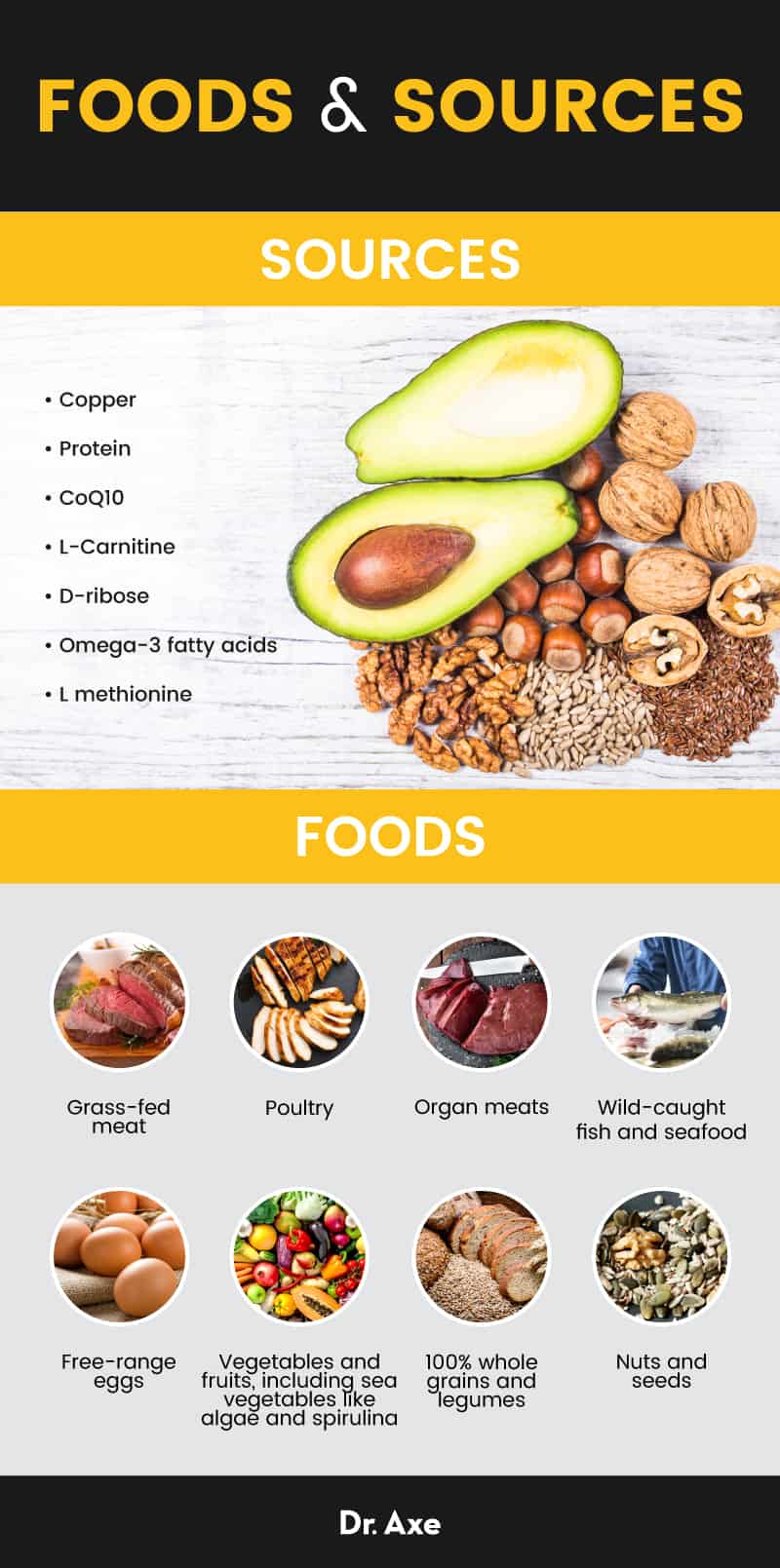This Dr. Axe content is medically reviewed or fact checked to ensure factually accurate information.
With strict editorial sourcing guidelines, we only link to academic research institutions, reputable media sites and, when research is available, medically peer-reviewed studies. Note that the numbers in parentheses (1, 2, etc.) are clickable links to these studies.
The information in our articles is NOT intended to replace a one-on-one relationship with a qualified health care professional and is not intended as medical advice.
This article is based on scientific evidence, written by experts and fact checked by our trained editorial staff. Note that the numbers in parentheses (1, 2, etc.) are clickable links to medically peer-reviewed studies.
Our team includes licensed nutritionists and dietitians, certified health education specialists, as well as certified strength and conditioning specialists, personal trainers and corrective exercise specialists. Our team aims to be not only thorough with its research, but also objective and unbiased.
The information in our articles is NOT intended to replace a one-on-one relationship with a qualified health care professional and is not intended as medical advice.
What Is Adenosine? Benefits for Heart Health, Sleep & Exercise
April 24, 2023

Adenosine is a type of neurotransmitter that is involved in energy metabolism and expenditure. You produce more throughout the day as your body does physical work and your brain carries out numerous cognitive functions. More is released in response to metabolic distress, exercise, oxidative stress and trauma, so levels in the body are always fluctuating.
Over the course of the day, your body usually accumulates more adenosine, which makes you feel tired and ready to sleep by night time. By the time you wake up the next morning, you’ve metabolized adenosine and should feel refreshed.
Adenosine can bind to purinergic receptors in cells, which produces a number of beneficial physiological responses. What is the action of adenosine on the brain, muscles, heart and other organs? As you’ll learn more about below, it possesses some of the following roles and benefits:
- Relaxing vascular smooth muscle (vasodilation) and increasing blood flow (circulation)
- Modulation of neurotransmitter release in the central nervous system
- Assisting synaptic plasticity
- Neuroprotection in response to oxidative stress
- Acting as an anticonvulsant molecule
- Regulating T cell proliferation and cytokine production
- Inhibiting lipolysis (the breakdown of fats and other lipids by hydrolysis, which releases fatty acids into the bloodstream)
- Stimulating broncho-constriction (constriction of the airways in the lungs due to the tightening of surrounding smooth muscles)
- Potentially helping muscles adapt to exercise, thereby improving endurance, power and strength
What Is Adenosine?
Adenosine is a natural chemical found inside all human cells and also a drug/supplement that is taken to manage many symptoms and improve energy levels.
What is the difference between adenine and adenosine? Adenosine is considered a purine nucleoside and a type of neurotransmitter. It is composed of adenine and D-ribose.
One of the most important roles that adenosine has is helping form other compounds, including adenosine monophosphate (AMP), which is a component of DNA/RNA, and adenosine triphosphate (ATP), which acts as a source of fuel within cells. Adenosine is first converted to its base, called adenine, and then converted to AMP. It also forms due to the breakdown/metabolism of ATP, which our cells use for energy, and by biosynthesis in the liver.
Taking creatine monohydrate can be useful for boosting production of energy in the form of ATP.
What is the role of adenosine when it comes to treating various health problems? Doctors use medicinal adenosine, either in IV form or supplement form that can be taken orally, to manage many types of health conditions, including:
- Irregular heartbeats
- Kidney failure or multiple organ failure
- High blood pressure/pulmonary hypertension
- Cystic fibrosis
- Lung cancer
- Unintended weight loss associated with cancer
- Nerve pain/neuropathy
- Varicose veins
- Bursitis and tendonitis
- Multiple sclerosis (MS)
- Shingles (herpes zoster infection)
- Cold sores and herpes simplex infections (including genital herpes)
- Poor blood circulation
- Fatigue and poor recovery from workouts
Types
AMP, ADP and ATP are all important participants in energy processes that keep our cells working and therefore keep us alive.
- Adenosine triphosphate (ATP) — ATP is the primary energy-carrying molecule in all living organisms on Earth. It captures chemical energy following the breakdown of molecules from food and uses this energy to fuel cellular processes. The three macronutrients (carbohydrates, proteins and fats) can all be converted into ATP.
- Adenosine diphosphate (ADP) — ADP is a nucleotide made up of adenine, ribose and two phosphate units. It is essential in photosynthesis and glycolysis and is the end product when ATP loses one of its phosphate groups. It is converted back to ATP by ATP synthesis.
- Adenosine monophosphate (AMP) — AMP is a regulatory molecule in metabolic processes, including glycolysis and gluconeogenesis. It can be converted to uric acid, which is excreted from the body via the kidneys.
- Adenosine deaminase (ADA) — ADA is involved in purine metabolism, is needed for turnover of nucleic acids in tissues, and supports development and maintenance of the immune system by converting toxic deoxyadenosine into lymphocytes. Infants and children who are born with a mutation in the ADA gene can suffer from serious malfunctions of the immune system that can be fatal.
- S-Adenosyl-L-methionine (SAM) — SAM-e is a molecule that participates in various biochemical reactions. It is second only to ATP as the most frequently used enzyme substrate. SAM is biosynthesized from ATP and is needed for proper function of the immune system, neurotransmitters and cell membranes.
What makes adenosine compounds different from one another is how many phosphate groups each one has. Each compound is composed of a nucleotide base called adenine, linked to a sugar molecule called ribose, linked to either one, two or three phosphates.
Benefits
Below are some of the major uses and benefits associated with adenosine:
1. Gives Us Energy and Supports Our Metabolism
ATP stores energy within cells and releases energy as needed, especially during periods of intense physical activity. It’s a major determinant of your metabolism, energy levels and body weight because it helps you convert the foods you’re eating to fuel that can be used to power your muscles, organs and cells.
2. Bolsters Heart Health
What does adenosine do to the heart? In prescription form, it is given intravenously to help correct irregular heartbeats, specifically the type called paroxysmal supraventricular tachycardia (PVST). It does this by slowing the conduction time through the AV node (an electrical “relay station” that controls heart beats) and interrupting the re-entry pathways.
Adenosine is able to relax vascular smooth muscles by reducing calcium uptake and activating adenylate cyclase in smooth muscle cells. It produces a mild reduction in systolic, diastolic and mean arterial blood pressure. It can increase blood flow in normal coronary arteries while at the same time preventing an increase in stenotic arteries.
Doctors also use adenosine when performing “stress tests” on high-risk patients, which are used to help identify heart blockages, blood clots and other related problems. Adenosine is a drug that affects the heart like exercise would, so it’s the most widely used drug for this type of test. It can help dilate the blood vessels, much like exercise would, making dysfunction more apparent.
3. Aids Relaxation and Sleep
What is adenosine’s role in promoting restful sleep? When it binds to A1 receptors in your brain, you feel calmer and sleepier. Your muscles feel more relaxed and your brain feels less alert. Adenosine can also bind to A2A receptors in the brain, which interferes with the release of neurotransmitters that affect your mood, including dopamine.
Overnight while you sleep, adenosine molecules are metabolized. This helps you to wake up feeling refreshed. Caffeine and adenosine are competitors, so it makes sense that while adenosine makes you feel more tired, caffeine makes you feel more awake. Caffeine does this by blocking adenosine from binding to certain receptors in the brain.
4. Supports Skin Health
What does ATP do for skin care? AMP can be injected into muscle tissue to support wound healing. It helps to promote healthy circulation, reduces swelling and fluid retention, and decreases symptoms like itchiness, redness and formation of ulcers.
AMP is used medicinally to treat shingles. Some research shows that adenosine may also be effective at reducing herpes symptoms and cold cores, but more studies are still needed to confirm this.
5. Boosts Athletic Performance and Recovery
ATP is used in supplement form to support muscle recovery and endurance, partially due to its effects on boosting circulation and dulling pain. Physicians can also inject adenosine into muscles to reduce swelling and treat conditions such as tendonitis or bursitis.
6. Helps Reduce Symptoms Associated with Cancer
Intravenous ATP is used to help reduce weight loss in people with advanced cancer because it can increase appetite and food intake.
Foods and Sources
Which foods can increase ATP? All macronutrients contribute to ATP production, but a diet that includes certain nutrients can help enhance production. The best way to support your body’s ability to make ATP is to consume foods that contain:
- Copper — Copper is involved in dozens of metabolic processes and is essential for the synthesis of adenosine triphosphate, therefore copper deficiency can result in a sluggish metabolism, low energy and other signs of poor metabolic health
- Protein (which provide essential amino acids)
- CoQ10
- L-Carnitine
- D-ribose
- Omega-3 fatty acids
- L methionine (which supports production of SAMe)
Foods that provide these nutrients include:
- Grass-fed meat, pastured poultry and organ meats, such as liver or kidneys
- Wild-caught fish and seafood, such as salmon, sardines, halibut, orange roughy, tuna, ling, pike, cod, cusk, sunfish, haddock and whitefish
- Free-range eggs
- Nuts and seeds
- 100 percent whole grains and legumes (it’s recommend to soak them first)
- A variety of vegetables and fruits, including sea vegetables like algae and spirulina
A balanced diet is important for maintaining high energy levels because each macronutrient has different effects on ATP. For example, when you eat carbohydrates, you consume glucose, which is converted to stored energy inside your muscles in the form of glycogen. Glycogen is then transformed via the process of glycolysis into ATP. Fat can also be used to increase ATP production, especially when carbs are not available.
Additionally, oxygen is needed for ATP production. Obviously we obtain oxygen from breathing, especially when taking deep breaths, doing deep breathing exercises and during physical activity when we breathe faster.

Supplements and Dosage
The easiest way to boost ATP levels is through eating a variety of healthy foods, since your body uses molecules from foods to make ATP and energy. However, recently adenosine and ATP have been incorporated into supplements that are marketed as energy boosters.
What kind of drug is adenosine? It can be used intravenously or orally. Adenosine supplements/drugs come in the form of ATP or AMP, which are used for different purposes.
What is adenosine used for in an emergency? A major therapeutic use of adenosine is as an antiarrhythmic drug, meaning it helps manage abnormal heart rhythms resulting from irregular electrical activity of the heart. It also can be injected into the space around the spinal cord to help reduce nerve pain. Additionally, adenosine phosphate can be injected into muscle tissue to reduce pain, swelling, itching and other symptoms. If you’re using adenosine medicinally, especially in IV form, your adenosine dose will be determined by your doctor.
Do adenosine/ATP supplements really work?
Because adenosine/ATP has an impact on energy metabolism, cardiovascular functions and blood flow, it is taken as an over-the-counter oral supplement to boost endurance and athletic performance, although there’s mixed evidence regarding its effectiveness. Some studies have found that adenosine taken orally is not very well utilized, leading to little increase in energy or other health improvements. (16) One reason that supplemental ATP may not be effective is because it’s metabolized extremely quickly, with a half-life of less than one second.
On the other hand, certain studies have found that ATP supplements can help increase muscle mass, build strength and reduce fatigue during physical activity. A study published in BioMed Central concluded that “oral ATP supplementation may enhance muscular adaptations following 12-weeks of resistance training, and prevent decrements in performance following overreaching. No statistically or clinically significant changes in blood chemistry or hematology were observed.”
Another study published in the Journal of the American College of Nutrition found that “oral ATP administration prevents exercise-induced declines in ATP and its metabolite and enhances peak power and muscular excitability, which may be beneficial for sports requiring repeated high-intensity sprinting bouts.”
Where to find and how to use adenosine:
- If you choose to try adenosine or ATP supplements, look for those that can be taken orally, such as being placed under the tongue or sold in capsule or powder form.
- Dosage recommendations vary depending on your goals and medical history. In studies where ATP supplementation has been shown to be beneficial, adults took doses of 225–400 milligrams per day over the course of 15 days to 12 weeks.
- You can use adenosine/ATP like other performance-boosting supplements, taking it about 30 minutes before you work out. If you’re not using adenosine/ATP for fitness-related goals, take it about 30 minutes prior to eating.
Risks and Side Effects
In IV form, adenosine should only be prescribed and given by a health care provider. While it’s usually safe, adenosine injections can potentially cause side effects at high doses, including chest pain, headaches, heart pounding, low blood pressure, nausea, sweating, flushing, light-headedness, sleep problems, coughing and anxiety.
Women who are pregnant or breastfeeding should not taking adenosine, since it’s not entirely clear if this is safe. People with gout and heart disease should also avoid using it since it can raise the level of uric acid in the blood and possibly reduce blood flow to the heart. Supplementing with adenosine may make symptoms of gout, such as tenderness and swelling, worse and complicate heart disease work by increasing chest pains and risk of a heart attack.
How is adenosine affected by caffeine? The two basically have opposite effects on your energy levels and concentration. When you consume caffeine, it blocks the effects of adenosine in your brain. Caffeine is therefore considered an “AR antagonist.”
Caffeine prevents adenosine from binding to various AR receptors (including A1, A2A, A3 and A2B receptors), reducing its calming effects. This is how caffeine makes you feel more energized and alert — and sometimes also more happy and upbeat. Caffeine can also block adenosine from binding to A2A receptors, which can increase the release of “feel good” chemicals like dopamine and glutamate that enhance your mood and motivation.
This is also the reason that adenosine should not be taken, or taken very carefully, with competitive methylxanthines, including caffeine and theophylline.
You should avoid taking it if you have any of these medications:
- Dipyridamole (Persantine)
- Carbamazepine (Tegretol)
- Gout medications, including allopurinol (Zyloprim), colchicine and probenecid (Benemid)
- Use adenosine with precaution if you’re also taking methylxanthines, including aminophylline, caffeine and theophylline
Final Thoughts
- Adenosine is a natural chemical found inside all human cells and an essential component of energy metabolism. It plays a role in the production of ATP, AMP and adenosine compounds that have important roles in the central nervous, immune, cardiovascular, respiratory and digestive systems.
- Actions of adenosine include relaxing vascular smooth muscle (vasodilation), increasing blood flow (circulation), modulating neurotransmitter release, protecting the brain from oxidative stress, regulating T cell proliferation and cytokine production, and helping regulate the sleep cycle/circadian rhythm.
- Doctors use medicinal adenosine, either in IV form or supplement form that can be taken orally, to manage health conditions including irregular heartbeats, organ failure, high blood pressure, cystic fibrosis, nerve pain, viruses that affect the skin, bursitis and tendonitis.
- Supplemental ATP is used to improve athletic performance, exercise recovery, strength, power and endurance. Studies have found mixed results regarding ATP’s effects, but certain studies have shown it can help prevent muscle wasting, improve sprints and support muscle adaptions in response to resistance training.











